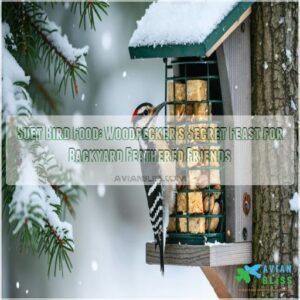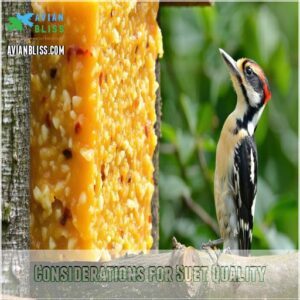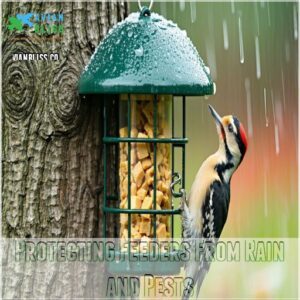This site is supported by our readers. We may earn a commission, at no cost to you, if you purchase through links.

This high-energy powerhouse packs a nutritional punch that’ll have woodpeckers flocking to your yard. You’ll want to choose suet cakes rich in protein and fat, perfect for fueling these feathered friends during winter’s chill.
Hang your suet feeder 5-7 feet high near tree trunks, using caged designs to outsmart squirrel raiders.
Pro tip: mix it up with peanut butter and birdseed for a gourmet treat.
Just remember to check weekly for freshness and clean those feeders. Think you’ve got what it takes to become a woodpecker’s favorite neighbor?
Table Of Contents
- Key Takeaways
- Benefits of Suet for Woodpeckers
- Choosing The Right Suet for Woodpeckers
- Woodpecker-Friendly Suet Recipes
- Best Practices for Hanging Suet Feeders
- Tips for Attracting Woodpeckers With Suet
- Maintaining Suet Feeders for Woodpeckers
- Frequently Asked Questions (FAQs)
- What kind of suet is best for woodpeckers?
- Will suet keep woodpeckers away?
- Where is the best place to hang a woodpecker suet feeder?
- Do you take suet out of a package?
- How can I stop squirrels from stealing suet?
- Will suet attract other types of birds?
- How long does homemade suet stay fresh?
- Can suet be used year-round for birds?
- Whats the best location to hang suet?
- Conclusion
Key Takeaways
- Choose suet cakes loaded with high-fat, protein-rich ingredients like nuts, seeds, and insects, which mimic woodpeckers’ natural diet and provide crucial winter nutrition.
- Position suet feeders strategically near tree trunks at 5-7 feet high, using caged designs to protect the food from squirrels and weather while creating a safe feeding environment.
- You can easily make homemade suet by mixing ingredients like peanut butter, rendered fat, birdseed, and dried fruits, giving you control over nutrition and saving money compared to store-bought options.
- Maintain suet feeders by regularly checking for mold, replacing spoiled suet, and cleaning feeders to keep your woodpecker visitors healthy and coming back to your backyard.
Benefits of Suet for Woodpeckers
If you’re looking to attract woodpeckers to your backyard, suet is the high-energy secret weapon that’ll keep these feathered friends coming back for more.
You’ll find that woodpeckers can’t resist this fat-packed food source, especially during lean winter months when natural food is scarce.
High-Energy Food Source
At the heart of bird nutrition, suet emerges as a powerhouse energy booster for woodpeckers. This high-energy food source packs a serious punch for feathered friends looking to thrive.
- Dense fat content fuels rapid metabolism
- Provides instant energy for tree-climbing adventures
- Supports muscle maintenance and feather health
- Concentrated nutrition in a compact package
- Mimics natural feeding patterns for woodpeckers
Woodpeckers devour suet like nature’s ultimate survival snack, transforming simple fat into pure wild resilience.
Winter and Early Spring Nutrition
When winter’s chill sets in, woodpeckers struggle to find enough calories to survive. High-energy suet becomes their lifeline, packed with essential nutrients during cold weather foraging.
As natural food sources dwindle, frozen suet benefits birds by providing critical nutrition during winter migration and early spring nesting periods.
This cold-weather bird food literally keeps them warm and alive.
Attracting Various Woodpecker Species
As winter’s chill gives way to spring, your suet feeder becomes a beacon for diverse woodpecker species. These feathered foragers are drawn to high-energy meals that fuel their survival.
Your backyard can transform into a woodpecker hotspot by offering the right suet, and don’t forget to minimize insecticide use to preserve insect populations for attracting woodpeckers.
- Pileated Woodpeckers love chunky, protein-rich suet cakes
- Downy Woodpeckers prefer smaller, softer suet portions
- Hairy Woodpeckers seek out sunflower seed-laden suet mixes
Choosing The Right Suet for Woodpeckers
If you want to attract woodpeckers to your backyard, selecting the right suet is vital for their nutrition and energy needs.
You’ll want to think about factors like ingredients, freshness, and whether to use homemade or commercial suet cakes to keep these feathered friends coming back for more.
Types of Suet Ingredients
The perfect suet ingredient blend starts with animal fat as your foundation.
Mix in birdseed, sunflower seeds, and crushed nuts to create a high-energy woodpecker feast.
Toss in dried fruits like raisins or apricots, and sprinkle mealworms for extra protein.
Your homemade suet recipe becomes a nutritional powerhouse that’ll have feathered friends flocking to your backyard buffet.
Homemade Vs Commercial Suet Cakes
Picking between homemade and commercial suet cakes boils down to bird preference and your time investment. Woodpeckers don’t play favorites, but smart birders know the pros and cons. Many birds, including woodpeckers, appreciate suet as a high energy boost, especially during cold weather.
- Homemade suet: Budget-friendly
- Commercial cakes: Consistent quality
- DIY recipes: Total ingredient control
- Store-bought: Convenient time-saver
Crafting your own suet log lets you customize nutrition while saving cash, giving backyard birds a gourmet experience without breaking the bank.
Considerations for Suet Quality
Every five suet cakes, one might spoil if you’re not careful. Woodpeckers deserve top-quality, fresh rendered fat that’s free from mold and rancidity.
Check your homemade suet recipe’s consistency regularly, focusing on high-energy ingredients that won’t compromise bird health.
Smart feeders know that suet quality directly impacts woodpecker nutrition, so store carefully and replace at the first sign of degradation.
Regular suet feeder maintenance, including check-ups for mold growth prevention, is key to providing a safe and healthy feeding environment for woodpecker nutrition.
Woodpecker-Friendly Suet Recipes
If you want to turn your backyard into a woodpecker paradise, crafting homemade suet recipes is your secret weapon.
You’ll discover easy-to-make, nutrient-rich suet blends that’ll have these feathered friends flocking to your feeders in no time.
Peanut Butter Suet Recipe
After exploring suet ingredients, you’ll love this peanut butter suet recipe that woodpeckers can’t resist.
Mix one cup of creamy peanut butter with one cup of rendered beef fat, then fold in two cups of birdseed blend.
Press the mixture into suet cake molds, creating a winter feast that’ll have feathered friends flocking to your backyard.
Natural and nutritious, it’s suet done right.
Bird Buffet Suet Recipe
If peanut butter suet caught your eye, the Bird Buffet recipe ups the ante for woodpecker dining.
Mix equal parts lard and cornmeal, then sprinkle in sunflower seeds and chopped nuts.
This buffet-style blend offers woodpeckers a protein-packed feast that’ll have them flocking to your yard.
Experiment with ingredient substitutions to keep your feathered friends coming back for more.
Expert-Approved Suet Cakes Recipe
Expert suet cake wisdom transforms backyard feeding into a woodpecker’s paradise.
By providing a high energy boost, blended suet cakes become a vital winter food source.
Blend equal parts beef fat and birdseed, mixing in peanut butter or lard for extra nutrition. Experiment with recipe variations like adding sunflower seeds or dried fruits.
Store in freezer for freshness, and watch woodpeckers flock to your homemade feast.
Cost-effective and simple, these suet cakes are a game-changer.
Best Practices for Hanging Suet Feeders
You’ll want to strategically place your suet feeder to attract woodpeckers.
while keeping it safe from rain, squirrels, and other pesky intruders.
By choosing the right location and using protective accessories like baffles and cages, you’ll create an irresistible dining spot for your backyard’s feathered friends. This will help attract woodpeckers.
Hanging Locations for Woodpecker Suet Feeders
After perfecting your suet recipe, strategic woodpecker suet feeder placement becomes key.
Hang your suet feeders at ideal heights between 5-7 feet, where woodpeckers feel most comfortable.
Choose locations near tree trunks or branches with partial shade, ensuring accessibility while providing a safe feeding station that mimics their natural foraging environment.
Safety and comfort drive successful woodpecker feeding.
Protecting Feeders From Rain and Pests
Once you’ve found the perfect spot for your woodpecker suet feeder, protecting it from rain and unwanted guests becomes your next mission. Weatherproofing isn’t just smart—it’s survival for your feathered friends and their high-energy meal.
- Install a dome-shaped baffle to shield suet from rain
- Use caged feeders to block squirrel invasions
- Choose feeders with
Suet Feeder Placement Tips
Position your woodpecker suet feeders strategically to maximize bird visits.
Mount suet bird feeders between 5-7 feet high near tree trunks or branches, providing woodpeckers easy access and protection from predators.
Opt for shaded areas away from direct sunlight to prevent suet from melting quickly. Make certain feeders are visible yet sheltered, creating a safe dining spot for your feathered backyard friends.
Consider using a tail prop design to support the woodpeckers’ natural feeding posture, enhancing their comfort and feeding efficiency.
Tips for Attracting Woodpeckers With Suet
Want to transform your backyard into a woodpecker paradise?
By strategically placing suet feeders with the right design and irresistible ingredients, you’ll create a high-energy feast that’ll have these feathered drummers flocking to your yard.
Using The Right Suet Feeder Design
When selecting woodpecker suet feeders, the right design can make all the difference in attracting these backyard acrobats.
Choose suet feeders that match your feathered friends’ needs with these key considerations: woodpecker suet feeders
- Opt for caged designs that discourage larger, bully birds
- Prioritize feeders with sturdy tail props for woodpecker comfort
- Select weather-resistant materials that protect suet from moisture
Offering Suet in Various Forms
After choosing the right feeder design, woodpeckers crave variety in suet presentation. Experiment with suet shapes and textures to keep these feathered friends coming back.
From classic cakes to innovative DIY mixes, your backyard buffet can become a woodpecker hotspot. Woodpeckers, like other birds, particularly benefit from suet’s high energy boost during colder months.
| Suet Form | Woodpecker Appeal |
|---|---|
| Cake | High traffic favorite |
| Log | Natural perching style |
| Nuggets | Quick energy bites |
Combining Suet With Other Food Sources
Someone can supercharge their woodpecker feeding strategy by mastering suet blends that complement other food sources.
Diversifying your backyard menu keeps these feathered friends coming back for more.
For an easy way to get started, consider purchasing pre-made suet woodpecker cakes online woodpecker suet.
Experiment with these combinations to attract more woodpeckers and keep your bird buffet exciting:
- Mix sunflower seeds with peanut butter suet cakes
- Sprinkle mealworms into commercial woodpecker food mixes
- Create fruit-enhanced suet with raisins or dried apricots
Maintaining Suet Feeders for Woodpeckers
If you want woodpeckers to keep visiting your backyard feeder, you’ll need to maintain your suet setup with care.
Check your suet regularly for signs of mold or spoilage.
Replace it promptly to keep your feathered friends healthy and coming back for more.
Regularly Checking Suet for Mold and Rancidity
At the heart of suet safety lies vigilant monitoring for signs of spoilage.
Woodpeckers depend on fresh, clean suet, so inspect your homemade or store-bought bird food weekly.
Discard any suet showing mold, odd colors, or funky smells.
A quick visual and sniff test can prevent potential health risks for your feathered backyard visitors.
Freezing Suet for Extended Freshness
After keeping mold at bay, freezing becomes your suet-saving superpower.
You can also buy pre-made suet products online at stores that sell freeze suet for birds.
Wrap homemade suet cakes tightly in plastic wrap or vacuum-sealed bags to prevent freezer burn. Pro tip: Label containers with preparation dates.
Frozen suet for woodpeckers stays fresh up to six months. Thaw overnight in the refrigerator before serving, ensuring your feathered friends get a safe, tasty meal.
Cleaning and Replacing Suet Feeders
Just freezing your suet doesn’t complete bird care. Keeping feeders clean matters most for woodpecker health. Regular maintenance prevents disease and attracts more feathered friends.
Knowing the benefits of suet feeders can encourage you to prioritize upkeep for the health of your backyard birds. Here’s your game plan for suet feeder upkeep.
- Inspect feeders weekly for debris and mold growth
- Scrub metal and plastic feeders with mild soap solution
- Replace feeders showing signs of wear or persistent grime
Your winged visitors will thank you for the regular suet feeder upkeep and maintenance.
Frequently Asked Questions (FAQs)
What kind of suet is best for woodpeckers?
Like a tree’s lifeblood fueling forest dwellers, high-fat suet packed with nuts, seeds, and insects works best for woodpeckers.
You’ll want to choose cakes with protein-rich ingredients that mimic their natural diet, ensuring these feathered drummers stay energized.
Will suet keep woodpeckers away?
Suet actually attracts woodpeckers, not repels them.
If you’re hoping to deter these birds, you’ll need different strategies like visual barriers, sound deterrents, or modifying your yard’s habitat to make it less appealing.
Where is the best place to hang a woodpecker suet feeder?
Imagine battling fierce woodland challenges!
Hang your suet feeder near tree trunks or branches where woodpeckers naturally forage.
protected from direct sunlight and rain, using a sturdy wire cage that allows easy bird access.
Do you take suet out of a package?
When you’re ready to feed birds, simply unwrap the suet cake.
Pop it directly into a wire suet cage feeder. No need to remove the protective paper.
Hang it outside and watch the woodpeckers feast!
How can I stop squirrels from stealing suet?
Use caged or upside-down suet feeders to block squirrels.
Install baffles above and below the feeder.
Place feeders away from trees or jumping points.
Try spicy suet cakes that deter rodents but won’t bother birds.
Will suet attract other types of birds?
You’ll absolutely draw in more than woodpeckers!
Chickadees, nuthatches, jays, and cardinals love suet.
These feathered friends will flock to your yard, especially during winter when natural food sources run low.
How long does homemade suet stay fresh?
Coincidentally, your homemade suet’s freshness depends on storage.
Refrigerate for 1-2 weeks or freeze for up to 3 months.
Always check for mold or rancid smell, and discard if it looks or smells off to keep birds healthy.
Can suet be used year-round for birds?
While suet primarily benefits birds during winter, you can offer it year-round.
Summer requires careful monitoring to prevent spoilage.
Choose heat-resistant recipes and replace frequently to keep backyard birds healthy and well-fed during warmer months.
Whats the best location to hang suet?
Imagine your backyard as a bird sanctuary.
Hang suet near trees or shrubs where woodpeckers naturally perch.
Choose a spot protected from rain and accessible to your feathered friends. Choose a spot away from direct sunlight.
Conclusion
Ultimately, your suet bird food journey transforms your backyard into a woodpecker’s haven.
By understanding their nutritional needs and strategically placing feeders, you’ll create an irresistible wildlife sanctuary.
Remember, consistent care and quality suet are key to attracting these fascinating birds.
Whether you’re a novice or experienced birder, mastering suet bird food for woodpeckers opens a window to nature’s most vibrant, pecking performers. Your feathered friends are waiting!
- https://extension.psu.edu/winter-bird-feeding-the-basics
- http://www.juliezickefoose.com/index.php
- https://www.birdsandblooms.com/birding/attracting-birds/feeding-birds/make-homemade-suet/
- https://www.almanac.com/suet-bird-food-recipe
- https://www.audubon.org/magazine/addictive-homemade-suet-will-keep-your-birds-returning-more













